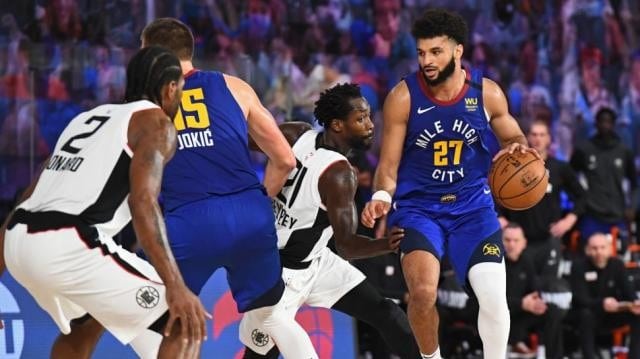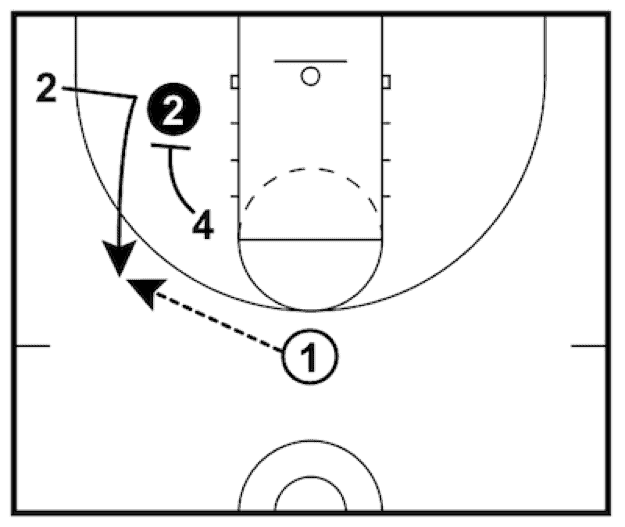Have you ever wondered what basketball commentators mean when they say ‘pick and roll’ or ‘pick and pop’? Do not worry, these aren’t complex concepts. The two concepts refer to a very effective offensive strategy called a screen.
A screen is one of the most physically demanding plays in a basketball game. This means that it is a very great offensive tool to use but also a dangerous one. Various types of screens can be used in basketball, and most of them can lead to violations. These violations can incur disastrous penalties such as free throws, offensive fouls, and turnovers.
With that said, let us dive into what a screen is in basketball, the various types of screens, how to properly set, and take advantage of it. We will also touch on what makes a screen illegal and a few tips and tricks to help you get better at performing the play.
The Basketball Definition of a Screen
A screen is also called a pick. It is described as an offensive play that can be made to block a defender and create a shot chance, or pass. A screen involves the offensive player standing behind or beside the defender to block him/her.
The person performing the screen is called the screener, whereas the teammate who benefits from the screen is called a cutter. The screen maneuver is more effective when performed by a bigger player with lots of physical strength. It is because of this reason that there are set rules limiting the number of maneuvers a player can make during a screen.
When a good screen is set, the offensive team usually has an added advantage of scoring or passing since the opposing defense has more work to do. Moreover, a majority of the time, you will find that the screener is the one who usually gets more chances of scoring. A screen is a basic but important basketball skill to learn if you want to create more chances of scoring for yourself.
Besides that, the maneuver can also become one of the most difficult stances to defend as it involves keeping an eye on two offensive players. You can perform a screen in two different ways; on-ball or off-ball.
On-ball screens are set when the goal is to create a passing chance or shot for the teammate with the ball. Off-ball screens on the other hand are set to give way for a teammate who doesn’t have the ball to open him up for a pass.
How to Properly and Definitively set a Screen?

A screen is a basic skill in basketball, but like every skill, it requires a lot of practice and ingenuity. The job of the screener is to disrupt the defense team as effective as possible to get the most out of the screen. To do this, several fundamentals have to be followed by the screener to maximize the maneuver. They include:
- Setting a wide strong base with your feet spread wide and knees slightly bent. This decreases your center of gravity to create a firm stance. Keeping your torso in a vertical position will also add to your stability.
- Make sure not to move your feet or try to lean into the screened defender, lest you get a moving screen – an illegal screen. The goal is to be stationary even if the defender moves. Moreover, if the defender accidentally bumps into you when you are moving, then the screen will count as an offensive foul.
- You should cross your hands across your chest or groin to protect the sensitive parts. That is across the chest for women and groin for men. This stance will also help in showing the referee that you are not grabbing, holding, or pushing the screened opponent.
- You must make contact with the defender you are trying to block. Contact should not involve a push, hold, or a foul.
- The most crucial fundamentals of a screen are angle, timing, and direction. You need to be able to correctly time and anticipate a defender’s position for you to block him/her. The right angle will prevent the defender from easily going around you or sliding under.
- The screener should also be square to the defender in the sense that his/her chest is in line with the defender’s hips and shoulders.
- Make sure to keep your elbows, knees, and legs in, lest you get a foul for them being out.
- Last but not least, you should make sure you have room to make a 180-degree turn to receive a pass after the screen is set. The 180-degree turn will provide you with free room to take advantage of the screen, receive a pass, and eventually make a shot. This is where you take advantage of the ‘pick and roll’ tactic.
The ball-handler also has to adhere to several fundamental guidelines to take full advantage of the screen. The most important one is timing. The cutter has to wait till the screen is definitively set before making a move or else the screener might be fouled for a moving screen.
Apart from timing, the cutter has to be effective at faking directions so that he/she can mislead the defender into the wrong direction. After which he/she must blast off of the screen as quickly as possible to make a shot.
In addition, the ball-handler needs to run shoulder to shoulder with the defender when coming off a screen. The maneuver will pressure the defender to trail behind you, thus creating more chances.
The Various Types of Screens
There are over seventeen types of basketball screens. These screens are either be on-ball or off-ball, but most of them are off-ball screens. They include ball screen, back screen, cross, double, drag, double, elevator, flare, flex, flat, hammer, floppy, ram, horns, staggered, step up, and UCLA screen.
We will touch on the most basic, standard, and fundamental screens to help you get a general idea of how they work. The way to take advantage of these screens would either be through a ‘pick and roll’ or a ‘pick and pop’.
The ‘pick and pop’ is an offensive play tactic in which the cutter takes advantage of the screen and proceeds to make a shot. A ‘pick and roll’ on the other hand entail the screener taking advantage of the screen to receive a pass, and then proceed to make the hoop.
1. Ball Screen
A ball screen is by far one of the best ways to maximize an offensive play. It is an on-ball screen that requires the screener to set up the screen for the ballhandler to make a shot.

Player 1’ is the defender awaiting the offensive player 1 who has the ball. In a ball screen, the teammate to player 1, that is player 4, will run towards player 1’ and create a screen to block him. This will give player 1 the chance to go around the screen and attack the hoop.
2. Down Screen
Down screens are mainly used to make sure shooters are open in the perimeter. It involves the screener’s back facing the ball as he faces the basket. Moreover, (s)he normally sets the screen low for a teammate near the block or for a perimeter teammate who is closer to the baseline.

Player 3 is the screener, 1 is the ball handler while 2 is the one who will receive the pass. As player 1 approaches the hoop with the ball, player 4 will proceed to set the screen for player 2. Player 2 will then fake direction with the defender, opposing player 2’, and blast off out of perimeter area. This is when player 1 passes the ball to 2 as (s)he proceeds to make an open three-point shot.
3. Back Screen
This is an off-ball screen meant to create a chance for a teammate to get a pass and finish with a layup. It involves the synchronized movement of three teammates with just one performing the screen.

Player 1 is the teammate who is going to benefit from the screen by receiving a disguised pass. Player 2 is the ball-handler and player 4 is the screener. The defender, player 2’ will be blocked by the screener from defending against the incoming player 1. Therefore, giving the ballhandler the chance to pass the ball to player 1 as (s)he proceeds to make the basket.
What Counts as an Illegal Screening in Basketball?
You may be wondering why a screen has so many rules to it. Well, the main reason is that, if the screen wasn’t well restricted, then the most physically strong players would have no resistance from average defenders.
The implication for that being that the opposing players would not get as many chances of defending themselves. Thus, making the game unfair to the team that has weaker players. Additionally, hard screens can sometimes result in collisions and players falling on the floor which can cause serious injuries.
With that in mind, some movements, posture, and spacing have been made illegal when a player is performing a screen. All the rules are meant to prevent an overly aggressive game that may lead to disastrous abrasions and conflict in the court.
Moreover, the opposing team gets a better chance at defending itself due to the illegality of some screen moves, such as the moving screen.
A referee may call a screen violation under the following circumstances:
1. Not Enough Space for the Defender
The referee will be the judge of whether there was enough space to enable the defender to avoid the screen. However, the screener has to ensure this by remaining stationary during the screen. The screener should not, under any circumstance, set the screen in such a way that the defender can’t be able to stop the screen.
2. Moving Screen
By far the most commonly occurring screen violation, the moving screen occurs when the screener moves into the defender’s way as they try to avoid the screen. It will occur either when the screener moves alongside the defender as the defender tries to escape the block, or when the screener prematurely dives into a ‘roll’ or ‘pop’.
Another occurrence of a moving screen will be when the ball handler doesn’t time the screen properly. This happens when the screener hasn’t yet set the screen but the ball handler proceeds to make his move.
3. Sticking Your Lower Body Out or Extending Arms
Doing any of these can be seen as an attempt to trip the defender or prevent them from going around the settings screen. The quickest and easiest way to get a foul would be to extend your arms in an attempt to block the defender.
4. Leaning Your Body into the Defender
A screener should not lean their body into the defender even if the screener is stationary. Leaning is usually an amateur move that most pros would never do. Beginners will often be tempted to lean since it pushes the defender away, but the referee will be quick to give a foul immediately.
Final Thoughts
A screen is one of the most fundamental offensive skills to learn as a basketball player. The play not only gives you chances of making the basket but also opening up the game to more aggressive plays. It should be noted that screens are favorable to players who are stronger than the rest. Regardless of the strength, a fine line has to be drawn between a good screen and an aggressive one.
Like any skill, constant practice is key to setting amazing screens like the ones set by Rudy Gobert, who had 471 screen assists in the 2019-2020 season alone.

